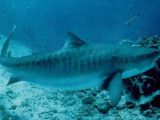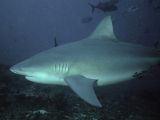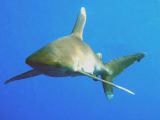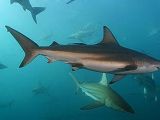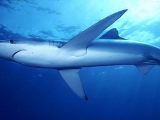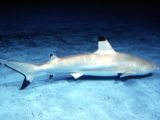The biology books say that sharks and rays make the group of cartilaginous fish, less evolved than most of the other species, that make the group of the bonny fish. Still, sharks, with their highly developed senses and teeth, make the top predators of the seas.
Paradoxically, the two largest species of shark, that make also the largest fish species, are harmless for people, being plankton feeders, like the whales: the whale shark (Rhincodon typus) (up to 20 m (66 ft) long and 34 tonnes in weight), basking shark (Cetorhinus maximus) (up to 9.8 m (33 ft) long and 4 tonnes). And also the megamouth shark (Megachasma pelagios) (up to 5.5 m or 18 ft).
Of the existing 368 species of sharks, only 20 are dangerous to humans. Of them, four account for almost 60-70 shark attacks registered annually worldwide. Up to 11 of these attacks are deadly. In 2006, 62 people were attacked and 4 died. 38 attacks occurred in the US, 7 in Australia, 4 in South Africa, 3 in Brazil, 2 in the Bahamas and one for each of the following: Fiji, Guam, Mexico, New Zealand, Puerto Rico, La Reunion, Spain and Tonga. The four deadly attacks occurred in Australia, Brazil, La Reunion and Tonga. This is a list with the sharks considered the most dangerous for people.
1.The Great White Shark (Carcharodon carcharias) represents the most fearsome sea predator, matched only by orca or killer whale (Orcinus orca), a mammal. Males can be 7.92 m (26 ft) long; females up to 4.3 m (14 ft) long. The largest weighed individual had 3.4 tonnes.
A giant conical head, a set of huge razor sharp serrated teeth, a carnivorous appetite, a malicious grin and a reputation of "man-eater" make the world's largest predator fish. The endangered species is protected in the waters of South Africa, Australia, Brazil, Namibia and the US; also, in the Mediterranean Sea. Most of its victims are signaled off California, south Australia, New Zealand and South Africa.
The white shark hunts everything from fish (including other sharks) to seals and dolphins, squids, turtles and sea birds, but as it ages, it turns bigger and slower, preferring seals, penguins and cadavers (especially of whales).
A strange issue is the white shark's tail: in most sharks is asymmetrical, while in this case is symmetrical. Like many shark species, the great white has to swim continuously so that oxygen-rich water enters into its gills through its mouth. That's why the sharks always display that freezing grin. What makes the great white shark and its relatives from the Lamnidae family (another two species of mako shark, porbeagle shark and salmon shark) different is their circulatory system. The blood temperature of these sharks is 3-5 degrees C higher than that of the water. This explains the speed and power of the Great White Shark, by accelerating digestion and increasing muscular power and stamina.
Surprisingly, 55 to 80% of the victims of a great white's attack survive. The great white sharks can suddenly attack swimmers, surfers or boats, sinking them, but humans do not seem to represent their favorite dish.
The white sharks bite once strongly and release the victim, inflicting deep wounds without any tear. This is a sophisticated hunting method: if the prey is not killed by this first attack/bite, the shark lets it escape to the surface just to inflict a second attack when the victim is already debilitated by the massive bleeding.
Why does the great shark proceed like this? It is believed that it is because of the eyes. Unlike other sharks, this species does not have an eye protective nictitante membrane. The huge shark rotates its eyes in the socket when chocking with the prey. The eyes could be exposed to the blow of a seal claw, that's why after inflicting the deadly strike, the shark releases its prey.
Because of this behavior, many human victims could be saved. This was possible also because the white shark does not hit feeding frenzy when smelling blood. This first bite also allows the shark to taste its victim. The white shark prefers fat preys, like seals, that provide the huge amount of energy necessary by its active lifestyle in cold waters. Human flesh is not fatty, that's why most white shark attacks end after the fist bite, but what consequences can such a taste bite have on humans?
Research proved that the killer damage seems to be due rather to razor-sharp saw-like teeth and not the sheer bite force. When applying the bite, the shark often shakes the prey from side to side to produce a sawing action. After that, the shark lets the victim bleed to death. Even so, the great white remains the most dangerous shark due to its size, massiveness and speed.
Many people living on the sea relate that the creature does not have a tooth for human flesh. These sharks seem to rather avoid people. Jacques-Ives Cousteau counted a meeting with a great white shark off Cabo Verde Islands, when the beast ran away rapidly leaving behind a 'cloud' of feces...
The species got its current negative image with the novel and movie "Jaws" of the '70s. That triggered a trophy hunting, and soon a white shark tooth cost $ 1,000 and a complete set $ 20,000. But no doubt about it, most great white sharks are killed by the fishing nets and by the hunt for shark fins used in making that infamous Chinese soup.
And remember that the Great White is a dwarf compared to its prehistoric relatives. Procarcharodon megaladon, a relative of the great white, that lived 65 million years ago, was 13 m (44 ft) long! It could have hunted whales...
2.While the Great White is the killer of the cold temperate seas, in warm tropical seas the nightmare is posed by another giant: the Tiger Shark (Galeocerdo cuvier). It can grow up to 7.5 m (25 ft) long and it is much more slender than the Great White: the largest weighed individual had 0.8 tonnes.
It attacks swimmers and divers, but also boats, and this species include the man amongst its preys, as it is not specialized on fatty sea mammals. It is the waste bin of the sea, engulfing everything: fish, other sharks (including smaller tiger sharks), rays, sea turtles, sea birds, sea snakes, corpses, and wastes thrown from the ships.
It has much smaller teeth than the Great White, but its head is much broader, betraying extremely developed jaw muscles. The tiger shark is considered to be a hyena of the shark world, having the most powerful bite amongst all living fish: this enables it to bite and swallow the hard shells of sea turtles like pieces of biscuits. The name Tiger Shark comes both from its ferocity and its pattern of stripes on its sides, an excellent camouflage in the waters of the reefs.
3.The Bull Shark (Carcharinus leucas) reaches a length of 3.5 m (12 ft) and a weight of 316.5 kg or 650 pounds. This massive shark is a relative of the tiger shark, and these first three species account for 99% of the annual victims of shark attacks, making a triangle of death.
Because it is smaller, many people underestimate the danger posed by it. Moreover, these sharks, inhabiting tropical and subtropical sea waters, enter freshwaters. In the Amazon, it has been found 3,700 km (2,300 mi) off its mouth.
The danger is increased by the fact that this shark prefers shallow waters, thus it can attack more than surfers and divers. It eats everything, like the tiger shark, and many past attacks of the sharks, put on other species, proved to have been the deed of this species.
4.Oceanic whitetip shark (Carcharinus longimanus) can be 3.96 m (13 ft) long and reach a weight of 167.4 kg (350 pounds). It is the most dangerous shark out of the deadly triad. This is the shark responsible for the classical open-ocean attacks after air or sea disasters (so much presented in movies). These sharks are very active and almost nothing detains them.
There is also a reef whitetip shark (Triaenodon obesus), but even if this species is aggressive and can bite, it does not poses too much danger, being much smaller (2.13 m (7 ft) long and weighing a maximum of 18.3 kg (40 pounds).
5.Copper shark (Carcharhinus brachyurus) reaches 3.25 m (10.8 ft) in length and weighs up to 304.6 kg (660 pounds). It is found from Japan and Mediterranean to New Zealand, Australia and Argentine, from the shore waters to depths of 100 m (330 ft). Attacks on swimmers or people practicing nautical sky have been attributed to this species.
6.The blue shark (Prionace glauca) is one of the most elegant shark species, reaching a length of 4 m (13 ft) and a weight of 205.9 kg (450 pounds). It lives out in the sea in tropical and temperate waters. It is one of the fastest shark species, known to attack both people and boats. Its "exploring bites" are deadly in many cases.
7.Blacktip shark (Carcharinus limbatus) is the terror of the coral reefs. Several species of blacktip sharks are known, but only this species, reaching a length of 2.75 m (9 ft) and weighing 122.8 kg (280 pounds) is known to be dangerous when provoked. The reef blacktip shark (Carcharinus melanopterus) may attack, but it is small (2 m (6.6 ft) long, weighing 13.6 kg (30 pounds)).
8.Shortfin mako shark (Isurus oxyrhynchus) is a relative of the Great White. Like its relative, it is powerful, aggressive, endowed with enormous teeth and high speed. It feeds on rapid oceanic fish like tuna on short bursts can reach 100 km (62 mi) per hour and make breaching of several meters over the water. It is a large shark: up to 4 m (13 ft) long, weighing up to 505.8 kg (1,100 pounds). This oceanic shark, from temperate and subtropical waters, has been connected to unprovoked attacks on swimmers and boats. Fishermen were attacked when bringing such sharks on the board of the ships.
Longfin mako (Isurus paucus), up to 4.1 m (14 ft) long, is considered equally dangerous. So are the other sharks related with the Great White, the salmon shark and porbeagle shark
9.Lemon sharks (Negaprion brevirostris) can be up to 3.8 m (12.6 ft) long, weighing 184 kg (400 pounds). These reef sharks are extremely aggressive when provoked and have been involved in several attacks on humans.
10.Hammerhead shark (Sphyrna genus) has sensory skills increased by these extensions on the side of the head. These sharks are rather shy, but they get close to swimmers, and their enormous size, power and teeth make them potentially dangerous. Potentially dangerous are the whitefin hammerhead (S couardi) (up to 3 m (10 ft) long), scalloped hammerhead (S lewini) (up to 4.3 m (14 ft) long and 152.4 kg (330 pounds) heavy), great hammerhead (S mokarran) (up to 6.1 m (20.3 ft) long and weighing 449.5 kg (1,000 pounds)) and smooth hammerhead (S zygaena) (up to 5 m (17 ft) long and weighing 500 kg (1,100 pounds)).
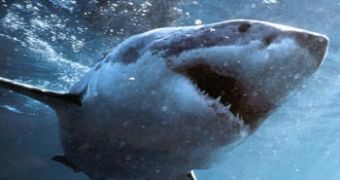
 14 DAY TRIAL //
14 DAY TRIAL // 
